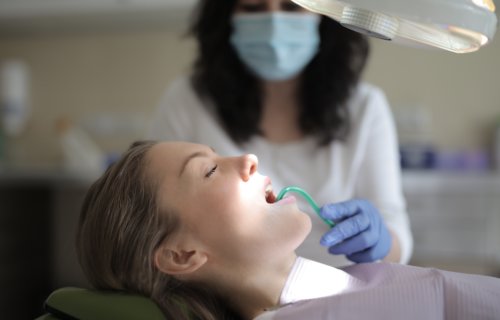COLUMBUS, Ohio — Are you someone who dreads a trip to the dentist’s office? For most of the coronavirus pandemic, both patients and dentists have been living with the same fear that dental procedures put them at high risk for COVID-19 exposure. However, a new study is challenging that whole narrative. Researchers from The Ohio State University say their tests find very little danger from COVID during teeth cleanings. In fact, study authors argue you’re just as safe in the dentist’s chair as you are drinking water in an office.
The study explains that much of this misconception about dental offices has to do with the way COVID-19 typically spreads — through aerosols. Tiny droplets coming from an infected patient’s mouth or nose can travel several feet and even survive on surfaces.
Anyone who’s sat with a dentist for a good cleaning will know there’s plenty of aerosol spray during these procedures. This has led many people to consider dental offices high-risk locations during the pandemic.
All that spray is not what you think
Study authors collected samples from dental personnel, equipment, and other surfaces aerosol sprays reach during a patient’s visit. After analyzing the genetic makeup of the organisms in those droplets, researchers discovered the vast majority are not coming from saliva.
In fact, the main source of any bacteria discovered in these rooms come from the watery solution in dental irrigation tools. Simply put, all the water dentists use to spray a person’s teeth during a cleaning is the same spray people see floating around the room after it leaves their mouths.
Even when researchers detected the SARS-CoV-2 virus in asymptomatic patients, the aerosols produced during their dental procedure did not show signs of carrying the coronavirus. With this in mind, study authors conclude the spray in the dentist’s chair is no more dangerous than the environment in the office outside.
“Getting your teeth cleaned does not increase your risk for COVID-19 infection any more than drinking a glass of water from the dentist’s office does,” says lead author Purnima Kumar, professor of periodontology at Ohio State, in a university release.
“These findings should help us open up our practices, make ourselves feel safe about our environment and, for patients, get their oral and dental problems treated – there is so much evidence emerging that if you have poor oral health, you are more susceptible to COVID.”
Tracking down the source of dental sprays
Previous studies have discovered that dental aerosols typically land on the healthcare worker’s face and the patient’s chest. The droplets can also travel for about 11 feet, landing on other surfaces in the room. However, these studies only determined that bacteria existed in the spray and never revealed where they came from.
In the new study, researchers recruited 28 patients getting dental implants or undergoing other procedures using drills and ultrasonic equipment. The group had their work done between May 4 and July 10, 2020 at Ohio State’s College of Dentistry.
The team took samples of saliva and dental cleaning solutions before the procedures and 30 minutes after. Researchers tested aerosols on the dentist’s face shield, the patient’s bib, and surfaces within a six-foot area of the dental chair.
Using genome sequencing technology, study authors could characterize the microbial mix of saliva and water-based cleaning solutions before and after each person’s appointment. Examining the bacteria this way allowed the team to look for variations in the genetic makeup of the microbes; identifying which family of bacteria or viruses they belong to.
“Some species that live in your mouth can closely resemble those in water and the environment. Using this method, we don’t even have to know the names of these organisms – you can tell whether they are exactly genetically identical or genetically different,” Kumar explains. “If you use this granular approach to see these very nuanced differences in the genetic code, you can very accurately identify where they’re coming from.”
Almost nothing harmful coming from saliva
Results reveal 78 percent of the organisms in dental aerosols are coming from irrigation water. Meanwhile, just 0.1 to 1.2 percent of these microbes anywhere in the room are coming from a patient’s saliva.
Researchers only detected salivary bacteria during eight of the 28 dental procedures and five of those patients did not use a pre-procedural mouth rinse. Additionally, 19 of these patients had the SARS-CoV-2 virus in their saliva. However, the virus was undetectable in the aerosols during all of their visits.
Prof. Kumar notes that dental irrigation dilutes the “thick, viscous” nature of saliva by 20 to 200 times. The lead author adds that dentistry has continued to lead the way in infection-control practices. Previous studies back that boast up, finding that less than one percent of dentists have tested positive for COVID-19.
“Dental surgeons and hygienists are always at the forefront of the war against bacteria in the mouth, and they of course did not feel safe because they are front-line workers surrounded by aerosol,” Kumar says.
“Hopefully this will set their mind at rest because when you do procedures, it is the water from the ultrasonic equipment that’s causing bacteria to be there. It’s not saliva. So the risk of spreading infection is not high,” she concludes. “However, we should not lose sight of the fact that this virus spreads through aerosol, and speaking, coughing or sneezing in the dental office can still carry a high risk of disease transmission.”
The study appears in the Journal of Dental Research.
